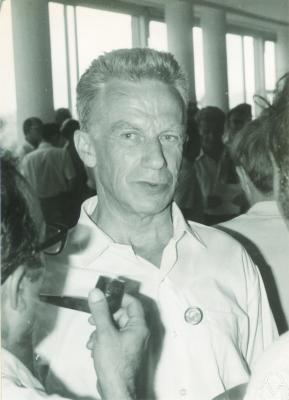Sergei Sobolev facts for kids
Quick facts for kids
Sergei Sobolev
|
|
|---|---|
| Сергей Соболев | |

Sobolev in 1970
|
|
| Born | 6 October 1908 |
| Died | 3 January 1989 (aged 80) |
| Alma mater | Leningrad State University, 1929 |
| Known for | Generalized functions Riesz–Sobolev inequality Sobolev conjugate Sobolev embedding theorem Sobolev generalized derivative Sobolev inequality Sobolev space |
| Awards | Lomonosov Gold Medal (1988) USSR State Prize (1983) Hero of Socialist Labor (1951) Stalin Prize (1941, 1951, 1953) |
| Scientific career | |
| Fields | Mathematics |
| Institutions | Steklov Mathematical Institute, Lomonosov Moscow State University, Kurchatov Institute, Novosibirsk State University, Sobolev Institute |
| Doctoral advisor | Nikolai Günther |
Sergei Lvovich Sobolev (born October 6, 1908 – died January 3, 1989) was a very important Soviet mathematician. He made big discoveries in areas of math like mathematical analysis. This field helps us understand how things change and move.
Sobolev came up with new ideas that are now basic parts of mathematics. One of his key ideas was about "generalized functions". These are also called "distributions". They help solve math problems that regular functions can't handle. He also created "Sobolev spaces," which are special groups of functions. These ideas made it easier to solve complex math equations.
Contents
A Life in Mathematics
Early Life and Education
Sergei Sobolev was born in St. Petersburg, Russia. His father, Lev Alexandrovich Sobolev, was a lawyer. His mother was Natalya Georgievna. The city where he was born changed its name twice. First, it became Petrograd, then later Leningrad.
Sobolev loved math from a young age. He studied mathematics at Leningrad University. He finished his studies in 1929. His teacher there was Professor Nikolai Günther. After graduating, he worked with another important mathematician, Vladimir Smirnov. Sobolev thought of Smirnov as his second teacher.
Working on Big Ideas
Sobolev started working in Leningrad in 1932. Later, in 1934, he moved to Moscow. There, he joined the Steklov Mathematical Institute. During World War II, he even led the institute when it moved to Kazan for safety.
From 1935 to 1957, he was a math professor at Moscow State University. He also worked at the Institute for Atomic Energy. From 1943 to 1957, he was a deputy director there. He played a part in important defense projects for the Soviet Union.
In 1958, Sobolev helped create a special computer called Setun. This computer was unique because it used a "ternary" system. Most computers today use a "binary" system.
Building Science in Siberia
In 1956, Sobolev and other scientists had a big idea. They wanted to create a huge science and education center in the eastern parts of the Soviet Union. This led to the creation of the Siberian Division of the Academy of Sciences.
Sobolev was a key person in this project. He founded and became the first director of the Institute of Mathematics. This institute was built in Akademgorodok, a science town near Novosibirsk. The institute was later named after him. He also helped start and grow Novosibirsk State University. In 1962, he spoke out for changes to the Soviet education system.
Sergei Sobolev passed away in Moscow.
Family Life
In 1930, Sergei Sobolev married Ariadna Dmitrievna.
See also
 In Spanish: Serguéi Sóbolev para niños
In Spanish: Serguéi Sóbolev para niños
- Mollifier
- Sobolev mapping

